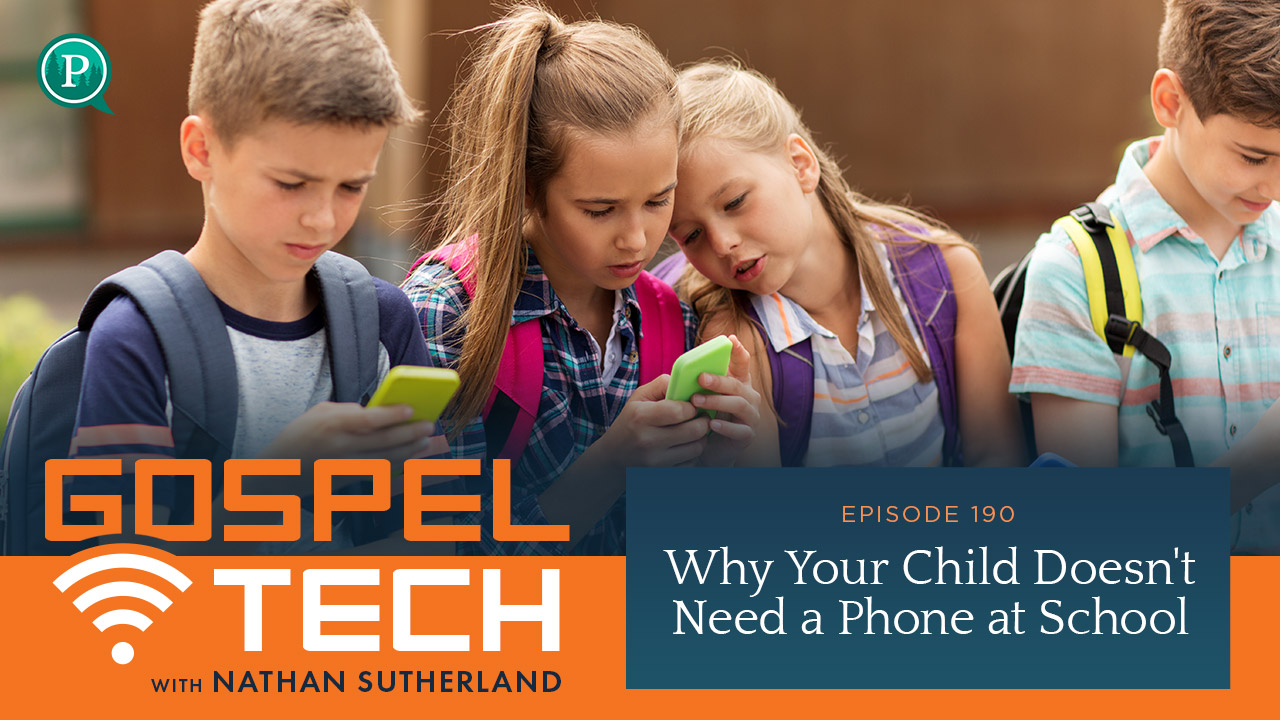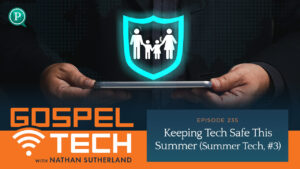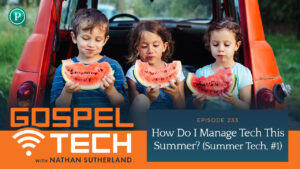As hope-focused parents who use all the tech that helps our children, and none of the tech that hurts them, our children don’t need smartphones at school. In fact, to quote a pro in the field of smartphones and social media, we need to get phones of out schools now (Jonathan Haidt).
Today’s discussion tackles this conversation in three steps:
- Why the smartphone conversation is different now
- What schools can do
- What we can do
Show Notes:
Three Canadian School District articles
• 2011: Toronto Including (May 19, 2011)
• 2017: Realization of issues February 26, 2017
• 2019: Ontario banning phones in its classrooms because they’ve found it’s a distraction to learning March 12, 2019
Haidt & Twenge Google Doc (330+ pages)
Gospel Tech Episodes: 186 | 187 | 188 | 189
13 pages of amazing resources and research on #phonefreeschools from Protect Young Eyes
Ways to listen:
🔗 click the link in the profile
🎧 search Gospel Tech in your favorite streaming service (iTunes, Amazon)
Transcription:
Heavenly Father, thank you for this opportunity to talk about technology with families. I ask God for wisdom as I speak, that you would bring encouragement to families who are raising young people in this tech world, that as we talk about smartphones and schools, that this would be an area that stirs up conversation and questions, and also, Lord, provides paths for people to provide the best possible education and raise up the healthiest possible young people in this tech world, to your glory and their good Lord. Ask this in Jesus’ name. Amen.
Hello everyone, and welcome to the Gospel Tech Podcast. My name is Nathan Sutherland, and this podcast is dedicated to helping families love God and use tech. Today, we are talking about smartphones in schools, and specifically why we need to get smartphones out of schools. This isn’t just my own clarion call, this is coming from Jonathan Haidt, a researcher out at New York University, who recently wrote an article pretty simply titled, “Get Phones Out of Schools Now.” It’s not super subtle. He is not a reactionary, he is not a technological Luddite, he is a researcher who’s been doing this work for six years, he’s teamed up with Jean Twenge of San Diego State University. This is an article published in The Atlantic a month ago, maybe, a month and a half ago. Let’s see, it’s beginning of school year, so two months, it was right before summer, so it was late June. And I waited till now, because I didn’t want to hit this with the big summer rush. But as we head back, and we’ve had this big conversation on how do we prepare our technology, this conversation needs to happen.
The results are in, the research has been done, and there are some wonderful resources to help us in this conversation, but just know, starting out in this conversation, smartphones need to be out of schools. If we care about the educational process, if we care about the students that we’re raising up, if we care about the teachers who are trying to do this work well, if we care about making this process functional, we have to get smartphones out of the classroom, and there’s stages and steps and ways to do that, but that’s the bigger picture on this conversation.
Again, please hear this, this is not out of fear, I’m not saying never own a smartphone, but I love this push by John Haidt, I love the idea of how he goes about it, and by the end of this, what we’re going to do is really three parts. We’re going to talk about why remove them? Why are we doing this now? Then we’re going to talk about, what can schools do? And the third thing we’re going to talk about is, what can we do? There are practical steps we can do, other than just being like, “I hate technology,” that’s not what this is about. We love technology, and as much as it helps us love our kids, love God, and love our neighbors and enemies. That’s the point of technology is leveraging our ability to do what God’s called us to do, so let’s do that well, and let’s not do it when it’s clearly a bad choice.
So that’s today’s conversation. You’re going to get equipped in those three areas, and I hope it’s both encouraging, maybe a little stirring up, I don’t want anxiety to come from this, but all right, if it makes you break a sweat because you’re thinking through it, that’s great, as long as I don’t leave you there. I want to get you to a spot where it’s practical and applicable. And so, with no further ado, let’s get this conversation started.
Welcome to the Gospel Tech Podcast, a resource for parents who feel overwhelmed and outpaced as they raise healthy youth in a tech world. As an educator, parent, and tech user, I want to equip parents with the tools, resources, and confidence they need to raise kids who love God and use tech. Thank you to everyone who’s helped make this podcast possible. Thank you for liking, for sharing, and for reviewing. If you have not, would you go to wherever you listen to podcasts, for example, if you listen to Apple Podcasts, you can scroll down, give us a rating out of five stars, that’s a huge help for people finding us.
And then, if you are willing to leave a one to three sentence review, say something you like, something that’s been encouraging, that helps people find us, it makes us show up higher on results lists when people search for us, and people can just be suggested. We’ve had multiple people write and be like, “Hey, I found you because I listened to this other,” Dad Tired was one, Fierce Marriage is another. Like, “I listened to this one and you were a suggestion.” That only happens because you guys engage this and listen regularly, so thank you for doing that.
Today’s conversation, getting smartphones out of schools. I have delayed this, because as I mentioned in the intro, frankly I didn’t feel qualified to be the one ringing this bell. There’s so much research, there’s so much stuff I’m still learning, and yes, I have strong opinions and they’re backed by research, but getting a pair of professionals who’ve written multiple books on it, who are the heavy hitters in the field of this research, who’ve been doing the research for at least six years, but they’ve now stacked it all up, as I’ve mentioned before, their shared Google Doc of 300 plus pages, goes back to 2012, starting to cull the research and put it together, and the end outcome is a massive Substack called After Babel that Jonathan Haidt runs.
But this article is the tip of the spear. It’s the most accessible, it’s the most concise. It gives you the three to five best research pieces, and teamed with some of the other resources I’ll reference today, you are going to have a cohesive conversation to lovingly discuss with your children, what’s the point of smartphones? How can we use them well? To discuss with your administration, what’s the point of smartphones in the education system? And to begin to apply culturally, across our communities and in our lives, tech in a good way, in a way that’s hope focused and healthful, rather than just convenient and around all the time, because we’re finding that that’s not the case.
So we’re going to start with, why now? Why remove it? And our first piece in answering why are we doing this now is simply because cell phones, and specifically smartphones, in the classroom are net loss. I can say that 10 years ago, it’s been longer than that because I’ve been out at the classroom for a couple of years here, so 14 years ago, when I started teaching, smartphones in the classroom was a dream. We were so pumped, because we saw technology meeting kids where they’re at, we didn’t have to have computer labs, we could have this device directly in the hands of our students. It’s the same device that they’re used to using all the time, and now we just put an app on it, and they can check their grades in real time, and they’ll see comments in real time, and they’re going to be able to get rid of those big heavy textbooks that are already out of date when we get them sometimes and they’re dragging around… I had kids in eighth grade dragging 40, 50 pound backpacks around because we didn’t have lockers.
So we were excited, they were going to get all this just directly through shared devices. We were so pumped, because we have veteran teachers who make incredible curricula, and they’re going to be able to share it with new teachers. When I started, I had four preps, none of which I had taught before, it was my second year of teaching, I had taught social studies. I came in my second year, got all new preps in language arts. I was cleared to teach both but wasn’t prepared to teach both. And while our district has common standards, we did not have common content, if that makes sense. So I showed up a first year teacher and just had to make stuff, or borrow stuff off other people, at which point they gave me a bunch of stuff, but I don’t know how to use it. And we were so excited like, “Oh, this is going to give us this common teacher-made professional curricula that we’re going to be able to deliver directly to students’ devices.”
And then, reality struck, and much like many things we try to do with good intentions, it didn’t work out. Suddenly, phones are out, and students are watching videos, students are using social media. I had a young lady who used social media, I asked her to put her phone away, and she’s like, “Okay, I just have to write this kid back.”
And I was like, “No, put your phone away now. You’re in the middle of a timed process that we’re doing in a learning environment.”
By the way, the research on what happens to your brain when you get distracted by social media, adults, this goes for us too, but for young people, it’s especially bad. They have a very hard time getting back to the task. And it ended up with this girl being in tears because she was using Snapchat, it left her friend on read, and she was worried that this friend was going to no longer be her friend if she didn’t respond quickly, because she had read it and now she needs to respond, which I think is a wonderful starting spot for a conversation about what does it mean to be a friend? And are you sure this person is one? She wasn’t in the spot where she was ready for that, but that’s a difficult teaching moment, and a difficult learning moment for that young person, and a difficult environment for all the kids around this now hysterically weeping student who previously were reading and trying to learn.
That is the kind of thing that we start having in the classrooms, and it’s very hard to put the lid back on Pandora’s box. We’ve already let the smartphones in. I have students everywhere I speak, in the middle school and high school level at least, I get kids with AirPods in, and they just constantly have a slow trickle of music on, and they’ve shared with me they feel very anxious if they don’t have that slow trickle of music going. I think that’s an important conversation to have about, is that a net gain? What can we do to help with our focus and with our learning? Because right now, smartphones, they were an attempt to be relevant and practical, and they’ve proven to not be. And that’s what we’re seeing right now is repeatedly proving through research and experience that smartphones, while they have some cool perks, sure, this cool app can help us learn in this way or engage in this way, all the other stuff is what we’re worried about. We’re not saying there aren’t awesome things, but the research is showing us that it’s a net loss.
A research referenced in this article by Jonathan Haidt is Brain Drain: The Mere Presence of One’s Own Smartphone Reduces Available Cognitive Capacity. This is the study that I’ve referenced previously where there’s three groups of students, you have a phone sitting in front of a student but not being used, a phone that is off in a bag, and a phone that is in the hall in a bag. None of these situations is the student engaging the phone, but in doing these academic assessments, the students with the phone out of the room, out of sight, did the best. And the study goes on to say that there’s apparently some kind of mental buffering where you have to think about not thinking about your phone, if that makes sense. And to use hypothetical numbers, let’s say you just have to use 10% of your brain’s bandwidth to not think about your phone, now you only have 90% of your mental bandwidth left to focus on the task. So there’s this loss of just having a phone out.
Sure, now it might buzz, now it might ring, now it might flash, there’s those options too, but we’re not saying that, we’re saying if the phone is just present, you can feel it in your pocket, you can see it in front of you, it takes some of your mental bandwidth, some of the focus you could be giving to another task, and in this case, it references brain drain. Just the presence of the device, because the device represents so many other things, it represents extreme connectivity, extreme amusement, extreme escapism, in addition to some more negative things, extreme trauma is also thrown in that list, and that is not conducive to a healthy learning environment, so removing them is then helpful.
It’s useful to note that while there are cell phone bans, the article from Professor Haidt goes on to say 77% of schools have a ban on smartphones, but the ban generally means no phones, unless they are related to classroom content, which he very wisely points out, that’s not really a ban, it’s just unenforceable, wishful thinking. So I do appreciate that, because that’s very much what I experience. You get these ideas like, “Oh, well, here’s our rules, just don’t do dumb things with your phone. Teachers, go ahead and try to enforce that.” And you’re like, well, all right, now, that’s a full nother job that I have to do, to try to play whack-a-mole with smartphones, which just teaches students to be sneaky. What we need is some kind of conducive policy.
So the second reason, versus this brain drain aspect of academic level, if we’re there to learn, smartphones are now proven to not be helpful in that process, they’re a net loss. You remove the smartphones, academics go up. We’re seeing it now across the country in the United States, but also across the world. The second reason is smartphones are more than a distraction, they’re a major cause of depression in young people. This is really important because a study that came out in February of 2023 showed that three in five teenage girls experienced prolonged bouts of depression or sadness. And that number’s horrifying, but to call the boys any better is, well, it’s just sad, it speaks to how bad it is, because one in three boys experience the same. So when one in three of teenagers experience depression and loneliness, when that’s the good stat, that’s horrifying.
Now, this is not anti-tech talking here, we are recognizing that’s a fact, standing on its own, this is what teens are reporting. What we then find is smartphones are causal, they’re not just related, and we’ll reference Haidt here again. He will specifically say in this article that, in 2019, there was reason to be skeptical, because the research wasn’t here, but in 2023, it’s no longer reasonable. He goes on to say social media is a major cause of mental illness in girls, not just a tiny correlate, and that’s a 10-page-long article where he will run you through the research if you want to see that, we’ll link it, it’s his After Babel Substack by that same title. So that line is in the article, but it’s also what it’s called. You can read that, you can check out the Google Doc between Twenge and him, but the premise here is this is not knee-jerk.
This is not, “We’re looking for something else to burn, because kids these days, and we’re worried,” it’s not any of those previous panics we’ve had where people freaked out about the printing press, which, by the way, if you want to see what the printing press did to public discourse, like the introduction of pamphlets and disinformation, there was reason for concern. But this goes beyond just, “It’s different, and there’s some negative aspects too,” this is actively fighting us and what we’re trying to do in the school space. So we need to get rid of it because it distracts from learning, we need to get rid of it because it’s a causal link with depression, and two-thirds of girls and one-third of boys in those middle school into high school ages are struggling with loneliness and depression, and that is not good for learning.
And then, we need to look at the school environment as something we can control. Why do we do this now? Because we can’t currently control homes. We can’t make parents be good parents and be engaged in this way, and we understand that not every kid’s got that. While yes, corporate responsibility is going to be huge, it’s not somewhere we’re currently at. There isn’t legislation that has enough teeth, or that even has the organization, to make this work yet. So we can start in our schools, and we can show the progress, and we can lovingly engage our students, helping them talk through tech, and say, “Hey, we love you and smartphones are great, when you’re healthy, and when it’s used correctly, and when it’s accountable.” We’re going to have that conversation, and, “This doesn’t make sense to use it in this environment. You shouldn’t have it in your bedroom, you shouldn’t have it in your classroom.” Those are two spaces where it’s just going to cause more problems and it’s going to cause benefit.
Thinking about though this idea of education is a place for learning, we do want to point out that there are laws that can help, so let’s point this out. Chris McKenna, Protect Young Eyes, has a great point, where he worked for Ernst & Young during the Enron debacle with accounting, and a law was passed, it said, “All right, executives of major corporations, you are going to be held personally accountable for this.” And turns out, Ernst & Young grew very rapidly after that, because they’re a wonderful accounting firm, and it hasn’t happened again on an Enron scale. It fixed. Well, we could do that with social media. And Chris McKenna, Protect Young Eyes, is a major part of helping those conversations, both with the tech companies, he works directly with companies like Meta and Instagram, but he also works on the legislative side, helping states do it, and then on the federal level, making rules that will be beneficial for both families and corporations, because it’s going to give guidelines that are helpful and products that are intentional.
So there is that to be done, but in the meantime, schools are the environment that we can affect today. You can take this information in. Let’s look at that then. What are the five things, based on this article, that schools can start doing now? You can start at the base level, begin the conversation, or you can jump both feet all the way in. These are Jonathan Haidt’s suggestions.
The first is have students keep their cell phones on their person, but not bring them out unless the teacher directs it. So if the teacher says, “Hey, we’re going to use this math program to help our conversation, we’re going to use this design program, this recording program,” whatever. All right, cool. The teacher directs it, smartphones come out. That’s your first step. I know that a lot of districts try to do that, my personal district does this. It does create some sticky spots, some teachers are going to go, “Oh sure, now you can take them out and listen to your music.” All right, cool, as long as the district’s on board with this and it’s clear what is happening, and how these boundaries are expected to be enacted, that’s great.
Second is, all right, students can keep their phones, but they have to be effectively off until an emergency happens. This is just for emergency contact. Oh hey, it’s lunchtime and you realize practice got moved. Okay, you can do it. You get hurt and you need to call home. Great, we can do that. The third step though is to have phone caddies, you’ve seen these for calculators, maybe, it’s basically like a sheet in the back of the room that has a bunch of pockets. You walk in, you drop it in there, or some kind of storage device. The concern being people’s phones can walk away, so you do need to think through how are you going to reasonably go get this? Is it behind the teacher’s desk? How do we make it so that people don’t mess with other people’s phones during the class time?
But setting up that this is how we are going to manage your phone, you can see it, it’s there, you have line of sight. That’s not the best, but you can do it. Or my personal favorite would be, I had a cubby behind my desk, and inside that would’ve been a perfect spot for this. You’d come in, you’d drop this into your little spot, and then that cubby closes, never to be bothered until class is over, and in the last three minutes or whatever, we go back and grab them. That’d be a great option.
The fourth option is, we’re going to do something like that, but now we’re going to have these locking sleeves you put them in. This is what some concerts do this, some comedic shows, some private parties do this for famous people, where you show up and you have to drop your phone in. Sure, there’s always the option that a kid brings a burner phone, but at least 95% of the devices are now gone, they are locked up. Sometimes, schools let the kids keep it on them, so they’ll say, “Hey, you can have your phone on you, but it’s going to be locked with this magnetic device.” Similar to a device that expensive items or clothing will have when you go shopping. Those are ink-based, but still magnetically locking and you can pull them apart. That’s another option. I’ve also seen some Kevlar bag locking options, but the idea is you’re going to lock it.
And then, the fifth option is that you’re actually going to make phone lockers, effectively. Every kid gets a spot to put it. Logistically confusing, certainly, would take some investment from districts, but this idea that you can bring your own device, we won’t mess with it, but it also can’t be out. We’re going to provide you a spot to safely put this away, and it’s going to stay there until you leave the premises.
I think that all five of these are awesome. The idea here is, we need to do something. We can’t just say, “But it’ll get better with time.” It’s not. The types of programs, specifically the drool tech out there that’s causing us to consume, that’s training us to need these distractions, and is aimed at taking our time, our focus, and our money, it is simply too powerful for brains that are not fully developed. That’s not a shot at young people, it’s a fact. They cannot inhibit their behavior enough to overcome the training of a really, really well-designed app or game. We need to give our young people and students the space, a buffer, a hedge, if you will, between their devices and the learning environments we’re trying to put them into.
It also will help, as Chris McKenna points out, with things like bullying and accidental porn exposure. That does happen because of these devices that are not at all controlled by the network or the district. One-to-one devices, at least the district has control over the network itself and those individual devices. They can choose to put on Securly or Bark or some other option for accountability, you can’t do that on a kid’s device. They have cell service, they’re not beholden to anybody.
So those are five things that districts can do. It is important to note, and he brings it up in his article, but what about emergency situations? What about when the worst possible thing happens, that there’s a school shooting or some other horrific event? Two things on that. The first is, we actually, in those environments, really do want to keep the space open for emergency responders, but it does eat up bandwidth when you jump hundreds of smartphones at the exact same moment across the same lines that emergency responders are trying to do, and we’ve seen that work out in the past.
But also, young people need to be present in those events. They need to be listening to their teachers, and being quiet, and getting as safe as possible. And that is not my words, that’s from Ken Trump, president of the National School Safety and Security Services, warning that, during a lockdown, our goal is locking down. And while I, as a parent with my three children in school, absolutely want to know that they’re okay, and let them know that I love them, that is not the best scenario for my children in that time. The school is set up for this, the teachers are trained for it, the young people are prepared, unfortunately, prepared for this, and what we need is those students to be present in those moments, not hundreds of parents showing up to a site that is not safe for hundreds of parents to be present, nor helpful for the emergency responders who are there doing their job.
So it is addressed in that, it’s addressed actually in several spots, but in that article, he does bring that up, which I think is the number one thing I’ve heard parents push back on. So keep in mind that is something we want to take into the conversation, and there are ways to lovingly support our kids, and our districts, and our emergency responders, in those cases. Which then brings us to, okay, but what can we do? All right, we can impact our schools, which will be one of these, but what can we do?
The first is start the conversation with your young people, with your family. Start talking about what does healthy tech look like, both the tech that we use, but how do we know if we’re healthy with it? What environments is this appropriate? What does it look like to use a smartphone well, if your kid has a smartphone or wants one? Certainly, Bark devices, and things like that, are a next step, where we can have a little more control and we can limit what is accessed during certain times, and everything we do online is then held accountable, and we’re notified for relationship. Not just to catch our kids doing something wrong, we’re saying, “All right, you did something wrong, and the only reason I care is because I love you. I’m not just here to police your life, I’m here to intervene and support you, and when something goes awry, whether it’s because you did it on purpose or someone else did it to you, I want to be someone who can intervene and lovingly ask the questions and help you get healthy and well.”
So that’s the first thing we’re going to do, talk about it. Talk about it with your community, with your children, with your school members. The second thing we’re going to do is we’re going to share this conversation, podcast 190. We’re going to share that with our friends, with our community, with our school administrators and teachers, where they can hear this conversation explained quickly and well. You can use episodes 1866 to 189 for part of the how do we use tech well, how do we prep our tech for fall and back to school? Talks about safe tech, talks about building hedges, talks about using tech on purpose.
And then, we need to make sure that we are building hedges for our own families, that we have rules set up around our network, our devices, and our families. So the second thing we can do is we can do our research. Please read this article, it’ll take you less than five minutes, the Jonathan Haidt article about Get Phones Out of School Now. Not a complicated title. You can Google it, it’ll pull it up, it’s on The Atlantic. Do that first.
Second, I would argue is read an article, that I can include in the show notes, by Chris McKenna, Protect Young Eyes, about how to talk to your school district about removing smartphones. It’s a couple of years old, he was way ahead of the game, but it’s a solid start and it connects to the third thing. Oh, excuse me. It doesn’t connect to the third thing, I’ll get to the third thing. The third thing you can do is, in doing the research, is check out that Haidt and Twenge shared doc, the Google Doc that’s been going on since 2019, that goes back to 2012, looking at the research that is built him up to the point where he’s convinced that science shows smartphones are a net loss in an educational environment.
Then, the third thing you can do is tell your admin, tell your school teachers, yes, we start at home, but the two resources I want you to have is Chris McKenna, Protect Young Eyes, he’s made an amazing resource, #phonefreeschools, 13 pages. Pages four through 10 are just research, it’s just the evidence we have for why this is not a great fit for our kids, our community, or our school environments. This is not what we want in a learning environment, because it’s not helpful, not because we’re scared, because we’re hopeful. So share that.
You can actually go to Protect Young Eyes, you’ll enter your email and they’ll kick it to you, 13 page PDF, and it’s an amazing resource for sharing with your school, and with your teachers, and with other parents in your community, your PTA. They all need this information to know what hope looks like in this environment, and why we’re not anti-tech, and we’re not knee-jerk, and we’re not, “Kids these days,” that’s not what we’re doing. We are saying, “Kids these days have amazing skills, abilities, and hope, and we want them to get all of that, and this isn’t helping, so let’s change it.” Finally, read the article. The Jonathan Haidt article is incredible.
So the idea here in closing is that we are not demonizing technology, or looking for an excuse to offload some responsibility we have on someone else. Instead, we’re recognizing what science says, we’re recognizing what experience says, we’re recognizing the purpose of education and the hope our children have, in light of their bright minds and their huge potential, and it’s not being helped by smartphones being in that learning environment.
So what can we lovingly do? Well, we can intervene, we can educate ourselves, and we can go to our school districts and begin pushing this issue intentionally, and saying, “Hey, we’re pro-education. We’re pro-kids. We’re pro the hard work you educators are doing. And we want to make that work even more effective, because having smartphones in the classroom is not part of it. In fact, it’s fighting us, and we want to be part of the change for our young people in raising them up in the way they should go, and showing them that there is a future that involves the technology that they both love and use, and that that’s not all of their future. That they need to be able to think for themselves, and engage education with deep focus and deep work,” as Cal Newport so lovingly puts it, “And that idea can’t be done with a smartphone in the learning environment.”
So I hope this is encouraging. I hope it was informational and accessible at the same time, because I’ll tell you, this gets me excited, but there’s also trepidation. I’m doing this for my school that my children go to, and there is this piece of like, “Man, people are going to… Right now, I’m the crazy tech guy who doesn’t like technology,” and it’s not true. But we do have that fear, and I just want to encourage you that it’s worth it. Sure, maybe some people are going to think that you’re doing this for bad reasons, but time is going to bear that out. Time is going to show that you both love your children, care about other people’s kids, and want the educational environment to be as strong and positive as possible, and the best way to do that is get smartphones out.
So I would love to hear how this goes for you. If you have any questions, you can reach out to me, [email protected], or find us on social media at LoveGodUseTech on Instagram and Facebook, and you can join us next week as we continue this conversation about how we can love God and use tech.
Follow this podcast:







